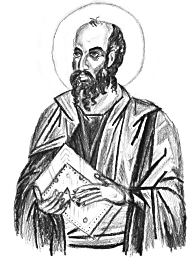After prayerful consideration, the members of Saint Athanasius Orthodox Church agreed to pursue purchasing property in Jessamine County. We plan to buy at least 7 acres of a large hill that is about 5 miles southeast of Nicholasville near Chrisman Mill Vineyards. I put together a page with lots of pictures of the hill if you want to look at it.
When I first heard about the property I was somewhat skeptical. I guess I always thought our church would move to somewhere in the city near a major road when we were large enough. I never pictured going to church out in the country on small roads. The idea of a church within walking distance of our homes has also been a dream of many of us and this seemed a step away from that.
Under the appropriate direction of our mission council, we spent the Fast of the Apostles in prayer about the land. I drove past the hill several times and had the chance to stand on top of it near the cemetery and watch the sun set. I began to get excited — I could see a church there.
So many different things changed my mind about the hill that it’s hard to identify all of them. I had been looking at pictures of Orthodox churches in Alaska and noticing that while some of them were not much to look at on the outside, they were all obviously Orthodox and many had cemeteries next to them. The Saint Alexander Nevsky Chapel is a typical picture. Father David explained that prayers take on a whole new dimension when you have a cemetery. Father Theodore mentioned that it’s a russian tradition to build churches on hills.
The hill itself is beautiful and deceptively large. Walking around on it, I got a strange sense of it being a special place. The current owner says he treats it like holy ground—God’s land. It certainly makes an impression on you. After being shown the land, someone from the UK school of architecture commented to Father David “if you’re going to travel to church, it should be to a spirtual place” and that visiting the hill had been that, even without a church there.
I think what really sold me was the realization that it wasn’t really far from Nicholasville, only 5 or 10 minutes. I used to drive all the way into Lexington to go to church; I’m sure I can drive a few miles into the country.
 Over a year ago I heard about the Six Days of Creation Icon Writing Workshop presented by St. Andrew Orthodox Church and considered attending. Due to my seeking the opinion of others and general procrastination and because the workshop quickly filled up, I was not able to participate last year. I was able to attend the public lecture series last year and I still contemplate them. Thankfully, St. Andrew is hosting the
Over a year ago I heard about the Six Days of Creation Icon Writing Workshop presented by St. Andrew Orthodox Church and considered attending. Due to my seeking the opinion of others and general procrastination and because the workshop quickly filled up, I was not able to participate last year. I was able to attend the public lecture series last year and I still contemplate them. Thankfully, St. Andrew is hosting the